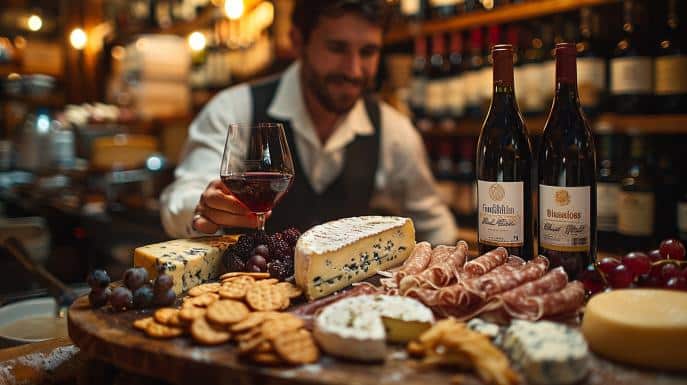Have you ever wondered how to elevate your gastronomic experience to a new level of pleasure? At the heart of this conundrum is the art of wine pairing—a delicate dance between flavors that can transform a simple meal into a memorable event. In “Wine Pairing Guide: Simple Tips”, we explore the world of the perfect pairing. We will discover together the secrets of pairing wine and food, the principles of wine pairing that guarantee a marriage of aromas and textures, and even how the ideal pair can enhance flavors and create a balance between your dish and your glass. Ready to become a master of wine pairing? Let’s enjoy this guide together.
Why is wine pairing essential for a complete gastronomic experience?
Pairing wine and food is crucial as it intensifies the flavors of the dish. Wines with a weight equivalent to the dish, such as a full-bodied red with roast meat, create a perfect balance in the mouth. The acidity of certain wines can cut through the fattiness of richer dishes, while the tannins soften upon contact with proteins, enhancing the food and drink simultaneously.
What are the best wine and food pairings?
The chemistry between tannic wines and protein-rich dishes creates perfect combinations, like Cabernet Sauvignon and a succulent steak. Acidic wines, like a vibrant Chardonnay, are the ideal pairing for fatty dishes, cutting the fat and balancing the mouth. And yes, sweet wines and spicy dishes can harmonize; a sweet Riesling counterbalances the spicy, preventing the burning sensation. Explore perfect pairing examples for inspiration and direction.
What are the basic rules for selecting a wine for different types of cheeses and desserts?
To pair wines and cheeses, intensity should be your compass. Let's uncover the truth about wine and desserts: yes, wine should have equal or greater sweetness than dessert. Ideal pairings follow the rule that intense cheese flavors demand robust wines, while milder cheeses pair with light wines. With desserts, a Port with chocolate is sublime because the wine is as sweet as the candy. The key to successful pairing is to balance the flavor profiles without one overpowering the other.
How to choose wines for special occasions and regional dishes?
The pairing of wines and regional dishes follows the adage: what grows together, goes together. This principle is the foundation for choosing wines for special occasions, as it celebrates the connection between local cuisine and the region's grapes. When preparing a dinner with dishes from a specific area, opting for local wine can highlight flavors that have evolved together over time. Cooking techniques, such as smoking or grilling, influence the profile of the chosen wine; wines with smoked notes complement grilled dishes. Plus, choosing wine doesn't have to be expensive; With a guide for wine beginners, you can find excellent value for money options that enhance the experience without compromising your budget.
In this article, we explore the essential art of wine pairing, from enhancing flavors to establishing a solid relationship between food and drink. We cover how the appropriate choice of wine can intensify a meal, balancing weight between dishes and wines, and the impact of acidity and tannins. Additionally, we discuss specific pairings for a variety of foods, rules of thumb for cheeses and desserts, and tips for selecting wines for special occasions and local dishes. Pairing wines is not just a science, but an art that enriches the gastronomic experience, inviting us to savor each moment at the table with depth and satisfaction.
FAQ
Why is it important to pair wines with food?
The ideal combination of wine and food intensifies the flavors of the dish, creating a perfect balance in flavors and textures. Wines are selected to complement or contrast with the food, enhancing the gastronomic experience.What are some recommended wine and food pairings?
It is recommended to combine tannic wines like Cabernet Sauvignon with protein-rich dishes like steaks, and acidic wines like Chardonnay with fatty dishes to balance the mouthfeel. Sweet wines like Riesling can also pair with spicy dishes, softening the spiciness.How do I select wines to pair with cheeses and desserts?
When selecting wines for cheeses and desserts, you must match the intensity of the flavors. More intense cheeses call for robust wines, while mild cheeses pair better with light wines. For desserts, choose a wine with the same or greater sweetness as the dish, such as a Port with chocolate.
- What guidelines should I follow when choosing wines for regional dishes or special occasions?
For regional dishes, the principle that “what grows together, goes together” guides the choice of local wines that can complement the region's cuisine. On special occasions, select wines with profiles that harmonize with the cooking techniques and ingredients used, always keeping the cost-benefit ratio in mind.



